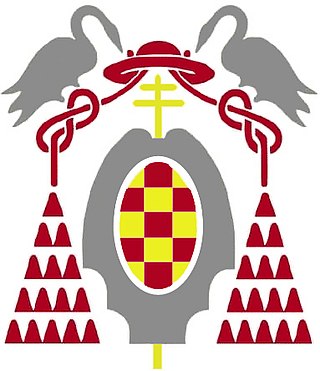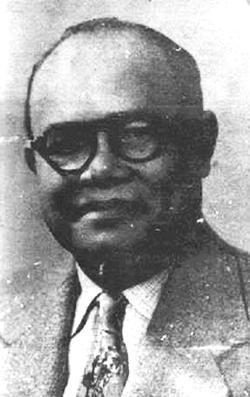
San Fernando, officially the City of San Fernando, is a 1st class component city and capital of the province of Pampanga, Philippines. According to the 2020 census, it has a population of 354,666 people.

The University of Alcalá is a public university located in Alcalá de Henares, a city 35 km northeast of Madrid in Spain and also the third-largest city of the region. It was founded in 1293 as a Studium Generale for the public, and was refounded in 1977. The University of Alcalá is especially renowned in the Spanish-speaking world for its annual presentation of the highly prestigious Cervantes Prize. The university currently enrolls 28,336 students, 17,252 of whom are studying for undergraduate degrees, who are taught by a teaching staff of 2,608 professors, lecturers and researchers belonging to 24 departments. The administrative tasks are carried out by the university's Administration and Services, comprising approximately 800 people.
Gregorio Fernandez Zaide was a Filipino historian, author and politician from the town of Pagsanjan, Laguna in the Philippines. A multi-awarded author, Zaide wrote 67 books and more than 500 articles about history, he is known as the "Dean of Filipino Historiographers." He was one of the founders of the International Association of Historians of Asia (IAHA), and president of the Philippine Historical Association for three terms. As a politician, he served as the mayor of his hometown of Pagsanjan from 1971 to 1975.

Fernando Amorsolo y Cueto was a portraitist and painter of rural Philippine landscapes. Nicknamed the "Grand Old Man of Philippine Art," he was the first-ever to be recognized as a National Artist of the Philippines. He was recognized as such for his "pioneering use of impressionistic technique" as well as his skill in the use of lighting and backlighting in his paintings, "significant not only in the development of Philippine art but also in the formation of Filipino notions of self and identity."

The University of the Assumption (U.A.) is a private archdiocesan Catholic university in the City of San Fernando, Pampanga, Philippines. The University of the Assumption is the first Catholic archdiocesan university in the Philippines and in Asia. It is among the top schools in the region, based on its accredited programs, and licensure and professional examination results.
Resil Buagas Mojares is a Filipino historian and critic of Philippine literature best known as for his books on Philippine history. He is acclaimed by various writers and critics as the Visayan Titan of Letters, due to his immense contribution to Visayan literature. He was recognized in 2018 as a National Artist of the Philippines for Literature - a conferment which represents the Philippine state's highest recognition for artists.
The Philippine Historical Association is a professional association of historians in the Philippines and is considered one of the oldest organizations of historians in the country. It was founded on September 18, 1955 by a group of prominent historians at Carbungco Restaurant located at Lepanto St., Manila. Among the group were Encarnacion Alzona, Gabriel Fabella, Gregorio Zaide, Nicolas Zafra, Celedonio Resurreccion, Teodoro Agoncillo and Esteban de Ocampo.

Felipe Landa Jocano was a Filipino anthropologist, educator, and author known for his significant body of work within the field of Philippine Anthropology, and in particular for documenting and translating the Hinilawod, a Western Visayan folk epic. His eminence within the field of Philippine anthropology was widely recognized during his lifetime, with National Artist F. Sionil Jose dubbing him "the country's first and foremost cultural anthropologist"

Ambeth R. Ocampo is a Filipino public historian, academic, cultural administrator, journalist, author, and independent curator. He is best known for his definitive writings about Philippines' national hero José Rizal and on topics on Philippine history and Philippine art through Looking Back, his bi-weekly editorial page column in the Philippine Daily Inquirer.
Juan Felipe de Jesús Nakpil, KGCR, KSS known as Juan Nakpil, was a Filipino architect, teacher and a community leader. In 1973, he was named one of the National Artists for architecture. He was regarded as the Dean of Filipino Architects.

Wilhelm G. Solheim II (1924—2014) was an American anthropologist recognized as the most senior practitioner of archaeology in Southeast Asia, and as a pioneer in the study of Philippine and Southeast Asian prehistoric archaeology. He is perhaps best known, however, for hypothesizing the existence of the Nusantao Maritime Trading and Communication Network (NMTCN), one of two dominant hypotheses regarding the peopling of the Asia-Pacific region during the Neolithic age.

José Protasio Rizal Mercado y Alonso Realonda was a Filipino nationalist, writer and polymath active at the end of the Spanish colonial period of the Philippines. He is considered a national hero of the Philippines. An ophthalmologist by profession, Rizal became a writer and a key member of the Filipino Propaganda Movement, which advocated political reforms for the colony under Spain.
Howard Brett Melendy was a prominent American historian, writer, researcher, publisher, autobiographer, dean, history professor, and filipinologist. Melendy was a professor and administrator at the San José State University in California and the University of Hawaiʻi. As a professor, he taught about the history of California and United States history. He was the first chairman of the history department of San José State University. j He was a life member of the American Historical Association.
Leandro Heriberto Caballero Fernandez, also known as Leandro H. Fernandez, was a Filipino historian who will serve as forerunner for later historians in the ranks of Teodoro Agoncillo and Gregorio F. Zaide. He is well known for being the first Filipino chairperson of the University of the Philippines Department of History. Notable among his works is A Brief History of the Philippines, a textbook for Grade 7 students during the American period.
Esperidión Arsenio Manuel, known as E. Arsenio Manuel, was a Philippine academic, historian, and anthropologist best known for his contributions to Philippine anthropology, history, literature, and linguistics. During a three-decade academic career at the University of the Philippines, he wrote a seminal survey of Philippine folk epics, and was responsible for discovering and publishing folk epics from the Manuvu, Matigsalug, and Ilianon peoples.

Gabriel Fabrero Fabella was a prominent Filipino historian during the 20th century. He is primarily known as the historian behind Philippine President Diosdado Macapagal's decision to issue Proclamation No. 28 on May 12, 1962, which changed the date of Philippine independence from July 4, 1946 to June 12, 1898 – the date when Philippine President Emilio Aguinaldo proclaimed the country's independence from Spain in Kawit, Cavite. For this achievement, Fabella became known as the "Father of June 12 Independence Day."
Tomas Saguitan Fonacier was a Filipino historian and educator. He is known for being the second Filipino chairperson of the University of the Philippines Department of History, and the first dean of the University of the Philippines Iloilo, which he helped found. Notable among his academic works is research on Chinese history and Ilocano history in the Philippines. According to the National Historical Commission of the Philippines, Fonacier's public service at the university, which spanned more than six decades, is the longest on record in that country.

The historiography of the Philippines includes historical and archival research and writing on the history of the Philippine archipelago including the islands of Luzon, Visayas, and Mindanao.

Luis Eduardo Valcárcel Vizcarra was a Peruvian historian, anthropologist, writer and activist. He was a researcher of pre-Hispanic Peru and one of the protagonists of the Indigenismo movement. He is considered the father of Peruvian anthropology, and his work focused on two fundamental axes: the revaluation of the Inca Empire and the vindication of the Andean culture. He brought awareness to the continuity that links the peasant of the Andes with the man of the Tahuantinsuyu.

Martin Jesus Imperial Tadeo Tinio Jr., more popularly known as Sonny Tinio, was a Filipino antiquarian, art historian, interior designer, architect, author, and cultural worker. He was best known for chronicling the history of Philippine colonial architecture and Philippine antiquities in various publications in both the Philippines and overseas.












